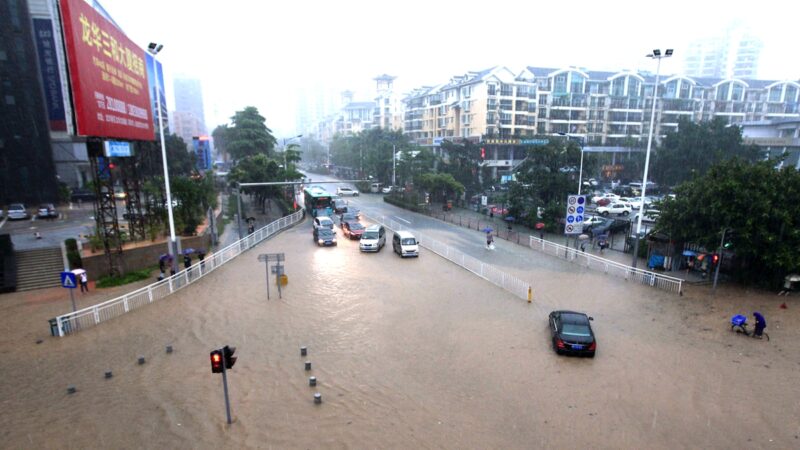[NTD News, June 23, 2021, Beijing time]As the epidemic in Guangdong continues to heat up, many places have been hit by heavy rainfall. Among them, the Shenzhen Meteorological Observatory issued a red rainstorm warning at 7:10 on the 22nd, announcing that the city has entered a state of emergency defense against rainstorms, and nurseries, kindergartens, and primary and secondary schools have been suspended.
At present, Shenzhen, Guangzhou, Foshan, Zhanjiang, Zhuhai, and Dongguan are all escalating the epidemic, and measures such as indirect “cities closure” have been implemented to strictly control the movement of people and strictly control traffic travel.
According to the Guangdong Health Commission’s announcement, as of 24:00 on June 20, the province has a total of 2,699 confirmed cases. However, because the CCP is accustomed to concealing the epidemic, the outside world has doubts about the authenticity of the CCP’s official statistics.
According to news from the Joint Prevention and Control Mechanism of the State Council of the Communist Party of China, the recent epidemics in Guangdong, Shenzhen and other places are all caused by the (Chinese Communist virus) mutant strain Delta. If the implementation of the emergency epidemic prevention policy is not accelerated, the epidemic will only spread to the whole of China. Unimaginable.
As the epidemic continues to heat up, many places in Guangdong have been hit by another round of heavy rains. Among them, the Shenzhen Meteorological Observatory issued a red rainstorm warning at 7:10 on the 22nd, announcing that the city has entered a state of emergency defense against rainstorms, and nurseries, kindergartens, and primary and secondary schools have been suspended.
The Shenzhen Meteorological Observatory issued a weather reminder for going to school on the 22nd. Luohu District, Nanshan District, Futian District, Bao’an District, Guangming District, Longhua District, Longgang District and Pingshan District (Biling and Longtian Sub-districts) have accumulated heavy rainfall. The heavy rainfall is expected to continue for another hour.
At about 7:15 am on the 22nd, the Shenzhen Meteorological Observatory issued a red warning of heavy rain in the above-mentioned areas, and at the same time announced the suspension of classes in the city’s primary and secondary schools, kindergartens, and nurseries.
At the same time, the city has entered a state of emergency defense against rainstorms, and relevant units are required to arrange staff to postpone work, leave work early or stop work as appropriate. The city immediately stopped large-scale outdoor activities, except for special industries, immediately stopped high-altitude and outdoor operations.
China’s Guangdong, Fujian, Guangxi and other provinces had heavy rains and heavy rains for three consecutive days.
There was a sudden downpour in Guangzhou on June 21. From 2 to 6 o’clock on June 22, strong thunderstorms generally occurred in Yuexiu and Tianhe districts of Guangzhou, accompanied by 6-8 gusts. There are 65 stations (accounting for 18.1%) with rainfall exceeding 50 mm in the city. Among them, Shawan Street in Panyu District recorded the city’s largest accumulated rainfall of 98.2 mm.
The Zhuhai Meteorological Observatory also issued an orange warning signal of heavy rain in Zhuhai at 7:35 on June 22. As of 10:13 that day, there were 10 rainstorm warnings in Guangdong, including 6 rainstorm orange warnings and 4 rainstorm yellow warnings. There are 6 thunderstorm and gale warnings, including 1 thunderstorm and gale warning orange, 5 thunderstorms and gale warning yellow.
According to meteorological and hydrological monitoring from 20 am on the 21st to 8 am on the 22nd, 42 towns and streets across the province recorded heavy rains of more than 100 mm, and 300 towns and streets recorded heavy rains of 50 mm to 100 mm. The Meteorological Department said the rain was pouring.
From June 21 to 24, there was a continuous process of heavy precipitation in Guangzhou, accompanied by strong thunder and lightning, strong convective weather such as magnitude 8 to 10 and short-term gale.
According to estimates by the Central Meteorological Observatory, high temperatures in North China, Huanghuai and other places will continue, and heavy rains in southern Jiangnan and southern China.
From 21 to 23, the rainfall in southern China, Yunnan, Guizhou and Sichuan was relatively strong. It is necessary to prevent disasters such as floods, waterlogging, and landslides in small and medium-sized rivers that may be caused by strong local rainfall. During the rainy period, some areas will also be accompanied by strong convective weather.
In addition, over the past week, more than 20 rivers in mainland China have experienced super-warning floods, covering Heilongjiang, Inner Mongolia, Jiangsu, Zhejiang, Chongqing, Sichuan and other provinces.
The Chinese Water Conservancy Agency recently held a meeting and stated that due to the impact of previous precipitation, the Heilongjiang and Nenjiang River basins have increased the number of rivers exceeding the warning water level and the amount of floods has been extremely large. The meeting stated that it is necessary to guard against this wave of floods in the northeast and heavy rainfall in the south.
Due to intensive heavy rains that caused floods in the past few days, a dike burst in Daxinganling, Heilongjiang, on the 19th also caused workers to be trapped. A total of more than 400 people were trapped in “isolated islands” in the water.
On June 20, the water level of the Huma River section in the upper reaches of the Heilongjiang main stream and the Huma River section, a tributary of Heilongjiang, rose rapidly. The water level of the Huma River Bridge on the 20th rose by 1.45 meters from the 19th. The local hydrological department stated that the flood peaked on June 23.
Except for Heilongjiang Province, at 7:48 am on June 19th, the water level of Qingyang Hydrological Station on Qingtong River, Qingyang County, Anqing, Anqing Province also rose significantly, reaching 14.29 meters.
(Reporter Li Yun comprehensive report/responsible editor: Li Quan)
The URL of this article: https://www.ntdtv.com/gb/2021/06/23/a103149175.html
